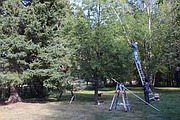Community members glean fruit trees to avoid bear encounters in extra active fall
Many people in northwest Montana know that the arrival of fall means hungry bears, but with an influx of new residents, state officials and local nonprofits are working to make everyone aware of what they can do to lower their chances of having a bear confrontation. Swan Valley Bear Resources partnered with Montana Fish, Wildlife and Parks to help homeowners get fruit off their trees as bears press further into populated areas in search of food.
At a residence in Ferndale, volunteers use long poles to jostle branches so apples fall down to the ground. They aren’t the prettiest that the tree produced this season, but it doesn’t matter because rescued bears like them all the same. The fruit gleaned and donated to Montana FWP last week is headed to the Grizzly and Wolf Discovery Center near Yellowstone, where food conditioned bears are taken to live the rest of their lives in safety. When they did this same drive last year, Bigfork Bear Aware organizer Tina Zenzola told the Eagle that donating fruit felt like saying sorry to bears who were food conditioned from getting into human garbage, especially since a couple of the bears at the sanctuary were rescued from the Flathead Valley.
Fall is primetime to glean fruit trees. Bears go into hyperphagia in autumn— this means their bodies know they are about to hibernate all winter and they are looking to pack on extra calories. But, Montana FWP Wildlife Management Specialist Justine Vallieres said the normal push to get as much food as possible is worsened by many factors that persisted from the summer. She said there’s no prevailing reason why we’re seeing extra active bears in human populated areas this year, but officials believe one reason could be a bad berry season.
“There's the factor of weather, like I said with berries, even natural foods, there's going to be off years sometimes. So, I think you just get some years that foods are not producing as much fruit or berries as normal. I think it could be due to the slow snow melt this spring— a lot more snow pack that stuck around longer and so that kept bears down in the valley bottom longer. Then we had a pretty cold and rainy June and that could have thrown things off. So yeah, there can be a number of factors that contribute to years like this,” Vallieres said.
Another factor is a growing population, she said as more people move to the valley they settle down in areas that bears typically utilize. Swan Valley Connections Program Manager Eli Estey said in rural areas like Ferndale, bears are really prone to go after fruit trees.
“Especially with black bears around here, they are built to climb trees, and fruit is a huge part of bears’ diets. Grizzlies and black bears love berries and whatever fruits they can grab and get their hands on. In these backyards, orchard trees are just a wonderful food source for them. Which is a little bit unfortunate, because when these trees either aren't fenced in with electricity or otherwise, and are just planted in a way that they have easy access for bears, they can get to them,” Estey said.
There are a number of things people can do to lower their chances of having a confrontation with a bear. Vallieres said keeping your property safe involves putting up or storing away things that are tempting for bears, much like how backpackers prepare their camp in the backcountry.
“If they're not using the tree, consider cutting it down and replacing it with a non-fruit bearing alternative. Also making sure there's no bird feeders out and that all pet food and livestock feed is put in an enclosure like a barn or a shed or garage. That also goes for garbage, to buying a bear resistant container or securing it in a garage,” Vallieres said.
Not only do bear confrontations pose a risk to humans, pets and livestock, they also pose a huge risk to the bear. Estey said the last thing they want is to see a bear get habituated, which means they are relying on non natural food sources. Bears who are at risk of being food conditioned are often relocated and in extreme cases, they have to be euthanized.
“Because enabling, or allowing bears to have access to food sources like these in our backyards, especially those that are highly tied to human activity can end up having bears develop bad habits, where instead of going in foraging for food sources out in the forest or the fields around here away from human inhabitants— they might actually seek out coming to these backyards, which you can see could be problematic for a number of reasons,” Estey said.
Vallieres said if someone is experiencing issues with bears to reach out to Montana FWP as soon as possible. She said the earlier they know of a problem, the less likely it is to escalate.
“The sooner we know about a conflict, the sooner we can properly respond and do what we need to do, whether that's helping secure attractants or, or if we need to set a trap to relocate. But a lot of people don't want to call or they wait to call days or weeks after there's been a problem. And the longer people wait, the worse the behavior can be and like it can escalate. So we want to get ahead of the problem before it escalates,” Vallieres said.
Swan Valley Connections offer resources for those interested in better securing their property from bears. Their Bear Aware program offers assistance in bear-proofing backyards. They offer free consultations and can financially aid and physically aid in setting up things like electric fences and getting people bear-proof trash cans. For more information, go to www.swanvalleyconnections.org/swan-valley-bear-resources.



